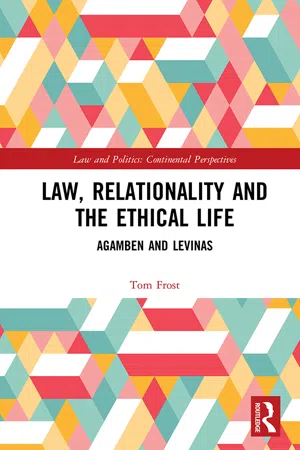
- 256 pages
- English
- ePUB (mobile friendly)
- Available on iOS & Android
About this book
This first book-length study into the influence of Emmanuel Levinas on the thought and philosophy of Giorgio Agamben, Law, Relationality and the Ethical Life, demonstrates how Agamben's immanent thought can be read as presenting a compelling, albeit flawed, alternative to Levinas's ethics of the Other.
The publication of the English translation of The Use of Bodies in 2016 ended Giorgio Agamben's 20-year multi-volume Homo Sacer study. Over this time, Agamben's thought has greatly influenced scholarship in law, the wider humanities and social sciences. This book places Agamben's figure of form-of-life in relation to Levinasian understandings of alterity, relationality and the law. Considering how Agamben and Levinas craft their respective forms of embodied existence – that is, a fully-formed human that can live an ethical life – the book considers Agamben's attempt to move beyond Levinasian ethics through the liminal figures of the foetus and the patient in a persistent vegetative state. These figures, which Agamben uses as examples of bare life, call into question the limits of Agamben's non-relational use and form of existence. As such, it is argued, they reveal the limitations of Agamben's own ethics, whilst suggesting that his 'abandoned' project can and must be taken further.
This book will be of interest to scholars, researchers, graduate students and anyone with an interest in the thought of Giorgio Agamben and Emmanuel Levinas in the fields of law, philosophy, the humanities and the social sciences.
Frequently asked questions
- Essential is ideal for learners and professionals who enjoy exploring a wide range of subjects. Access the Essential Library with 800,000+ trusted titles and best-sellers across business, personal growth, and the humanities. Includes unlimited reading time and Standard Read Aloud voice.
- Complete: Perfect for advanced learners and researchers needing full, unrestricted access. Unlock 1.4M+ books across hundreds of subjects, including academic and specialized titles. The Complete Plan also includes advanced features like Premium Read Aloud and Research Assistant.
Please note we cannot support devices running on iOS 13 and Android 7 or earlier. Learn more about using the app.
Information
1 An ever-divided life
Introduction
Biopolitics and the division of life
The appropriation of Foucault
Table of contents
- Cover
- Half Title
- Series Page
- Title Page
- Copyright Page
- Table of Contents
- Acknowledgements
- Table of cases
- Table of statutes
- Introduction: Continuing an abandoned project
- 1. An ever-divided life
- 2. The transmission of negativity
- 3. Immanence, Levinas, ethics and relationality
- 4. The inoperative potential of a messianic life
- 5. Agamben's hyper-hermeneutics
- 6. The origins of form-of-life
- 7. The limits of form-of-life
- Abandoning a continued project
- Bibliography
- Index